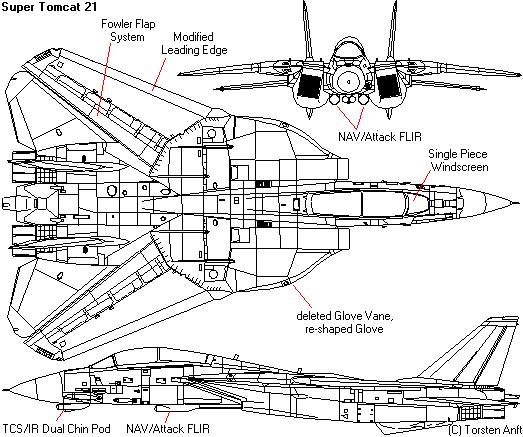
F-14 Tomcat:
History
Specifications
Bureau Numbers
Walk-Around Details
Squadrons
Photos
Books
Memorabilia
Other Topics:
Grumman A/C
EXTRA 400
A/C Photos
Links
Guestbook
Credits
The Author
(Grumman Corp.)
The design work on the advanced versions of the Grumman F-14 began as early as 1987 and should bring the F-14 design beyond the limits of the F-14D since the growth potential of the F-14 was not yet reached. And therefore, the Super Tomcats were developed as an alternative to a navalized ATF (Advanced Tactical Fighter). But, the Super Tomcats were never more than design concepts or scale models.
The first step into the future was the F-14D Quickstrike. It would have featured an improved APG-71 radar with new modes for air-to-air and air-to-ground strikes and modifications for more stand-off weapons like the Harpoon, HARM and SLAM (Standoff Land Attack Missile) missiles.
Even though the F-14D Quickstrike did not meet the Navy's requirements for range and payload (as specified for the ATF), it did come closer than anything else, especially the F/A-18E/F. There is another major difference between the F-14D Quickstrike and the F/A-18E/F: The development costs! The F-14D Quickstrike needed only software changes and some internal modifications, nothing more. The F/A-18E/F is nearly a complete new airframe with consequently high development costs.

The next design-step should have been the ST21. ST21 stands for Super Tomcat for the 21st Century. It was an revolutionary upgrade of the existing F-14D model. The most obvious modification was the new glove area: Instead of the retractable glove-vanes of the A model, the glove was enlarged to take the place of the extended glove-vane. This modification should enhance the supersonic flight characteristics as well as the dogfighting capabilities. Additionally, this modification would have solved the structural problems in the glove area.
Another very obvious modification was a newly introduced single piece windscreen. This would have given the pilot a much better frontsight compared to the relatively restricted view of todays Tomcats.
Further aerodynamic improvements were revised wing leading edges and a Fowler flap system.
Finally, the last visible modification were navigation and attack FLIR (Forward Looking Infrared Sensors). The pods for this sensors found their place in the forward Phoenix rail fairings, which until then housed the oil cooling system for the AIM-54A missile. Since this cooling system is no more needed for the B and C missile, weight was saved by deleting it and a place for the new pods was free.
The ST21 could have been equipped with an upgraded version of the F110 engine, the F110-GE-429. These engines would have given extra thrust and even more fuel efficiency: The engines puts out 29,000 to 30,000 lbs of thrust each in maximum afterburner.

All the above mentioned modifications, including lighter avionics and engines, accounted for an increase in empty weight of 1,000 lbs and in gross weight of some 2,000 lbs. Structural changes in the glove allowed an extra 2,200 lbs of fuel in each glove while saving structural weight in the newly designed glove. This would increase the ST21s internal fuel quantity to 18,500 lbs! Further, the bringback capability increased from 9,000 lbs (F-14D) to some 16,000 lbs while the approach speed dropped 15 knots due to the new glove and wing design. The ST21 could launch at gross weight with a 7 knot tail wind on the deck.
As well as the F-14D Quickstrike, the ST21 is just an upgrade, that means any of the already existing F-14Ds could have been remanufactured to ST21 standard at consequently low costs!
As developed by Grumman engineers, the next step could have been the AST21 (Attack Super Tomcat 21st Century). The AST21 is simply a more attack-oriented model of the ST21 and was thought to be an alternative for the navalized ATF. Modifications on the AST21 are nuclear weapons capability, bomb stores under the engine nacelles (normally used for external fuel tanks) and a FAC (Forward Air Controller) mode modification to the radar system. Also, the TCS and IRST would be made removeable to save weight in the air-to-ground role. If needed for air-to-air scenarios, they could be easily fitted and give the AST21 a full air-to-air suite.
Additional armoring for the crew area and an Integrated Defensive Avionics Package (IDAP) were planned for the AST21, too. And since bombs would generally be carried in the tunnel, the AST21 would retain fighter-like maneuverability unlike any other attack aircraft. Again, the AST21 could be remanufactured by rebuilding existing F-14Ds.
The final upgrade could have been the ASF-14 (Advanced Strike Fighter). While the F-14D Quickstrike, ST21 and AST21 would have preserved as much of the basic F-14 design and systems as possible, the ASF-14 would have only looked like an F-14. It would have taken full advantage of the new ATF and ATA (Advanced Tactical Attack Aircraft) technologies. But the ASF-14 would have been a lot more expensive to develope than the ST21 (but still a lot cheaper than the F/A-18E/F) and it wouldn't have had that much more warfighting capabilities than the ST21. Remanufacturing would not have been possible, all ASF-14s would have been new aircraft. Therefore, the ST21 or AST21 would have been the more probable aircraft.
But as of today, all future F-14 programs are canceled. That's the end of the Tomcat story, the end of the Advanced F-14 Family, the predecessor of any future Advanced Tactical Fighters.
Top of the page
F-14 Tomcat History:
Photos of early testing and production | Export Tomcats | F-14B: The next step | F-14D: The best ever
Grumman proposals for the future | Today & Tomorrow | F-14 Combat Records
F-14 Tomcat:
Other Topics:
Start Page Foreword FAQ Updates
Copyright © 1997-2001 by Torsten Anft